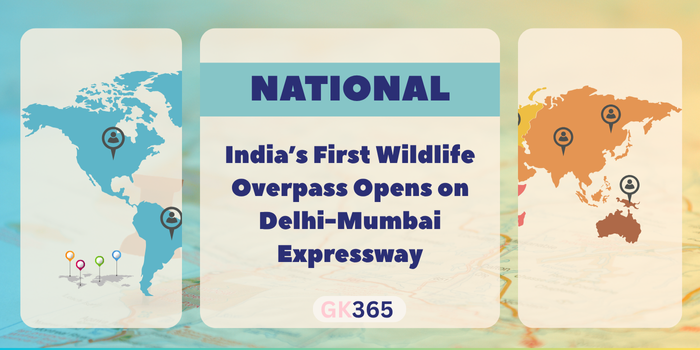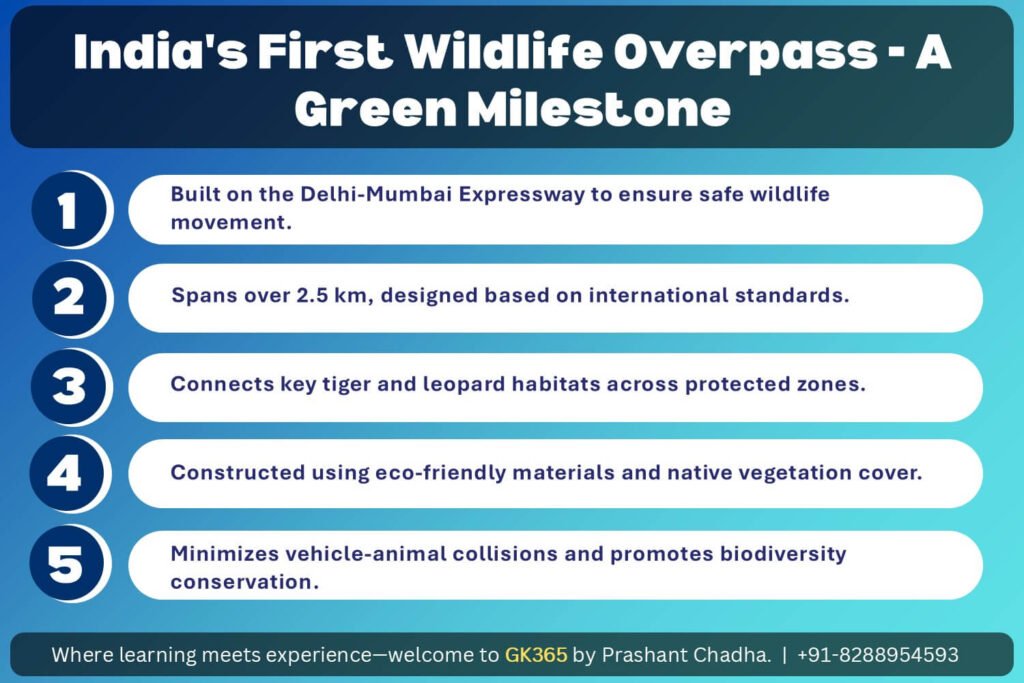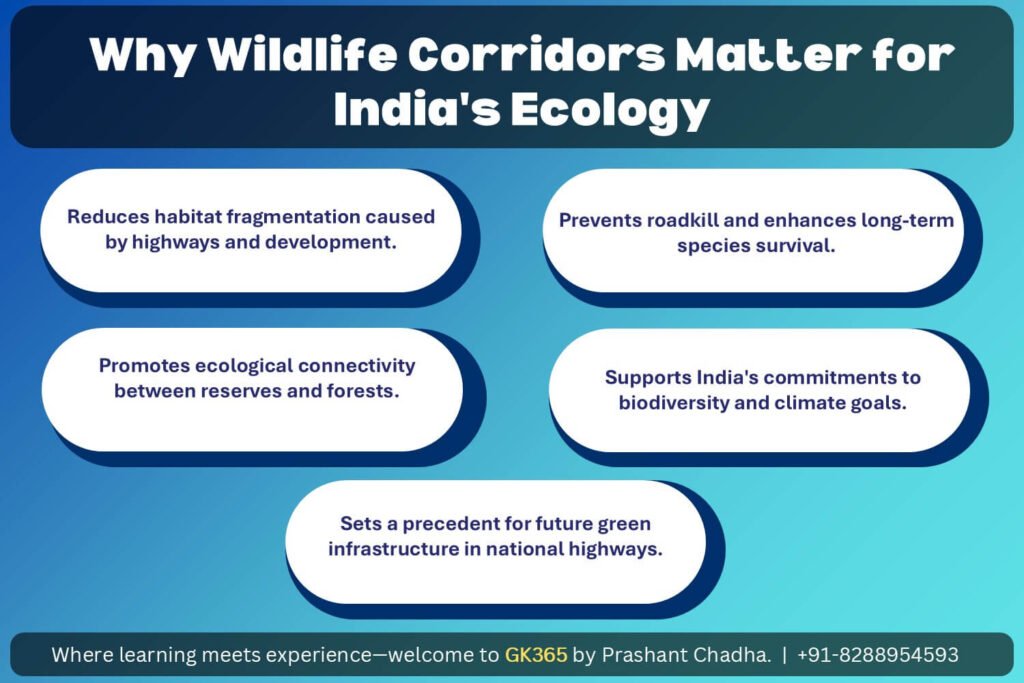Introduction
The National Highways Authority of India (NHAI) has built the country’s first wildlife overpass corridor on the Delhi-Mumbai Expressway. The 12-kilometre stretch runs through the buffer zone of the Ranthambore Tiger Reserve. This project combines modern road design with wildlife conservation goals.
The corridor includes five large overpasses, India’s longest wildlife underpass, and several other eco-friendly features. These help animals move freely across the landscape without interference from traffic. The design also reduces human-animal conflict in protected areas and reflects India’s shift toward sustainable infrastructure.
Table of Contents
- What is a Wildlife Overpass and Why is it Important?
- Why is This Project in the News?
- Key Features of the Delhi-Mumbai Wildlife Corridor
- Environmental and Eco-Friendly Measures
- Objectives and Long-Term Impact
- India’s Shift Toward Wildlife-Friendly Highways
- Global Examples of Wildlife Corridors
- Frequently Asked Questions (FAQs)
- Conclusion: Paving the Way for Green Infrastructure
- Key Takeaways Table
1. What is a Wildlife Overpass and Why is it Important?
A wildlife overpass is a bridge made for animals to safely cross roads. These structures help prevent animal deaths and keep their habitats connected. Most are covered with plants and trees to resemble natural surroundings.
Why It Matters
- Prevents animal deaths on highways
- Keeps wildlife habitats linked
- Reduces road accidents caused by animals
Countries like Canada, the Netherlands, and the United States have already adopted this model with success. India is now beginning to follow their lead.
2. Why is This Project in the News?
This is the first time a national expressway in India has been planned with wildlife protection at its center. The Delhi-Mumbai Expressway, which passes near the Ranthambore Tiger Reserve, now sets an example for other infrastructure efforts.
As roadkill and habitat encroachment increase, this project shows how development can respect the environment.
3. Key Features of the Delhi-Mumbai Wildlife Corridor
- Wildlife Segment: 12 km through the Ranthambore buffer zone
- Overpasses: 5, each 500 metres long
- Underpass: 1.2 km—longest in India
- Terrain Fit: 5 km of sunken or raised road to match the land’s shape
- Safety Barriers: 4-metre-high walls and 2-metre sound barriers
- Camera Evidence: Tigers and bears have been recorded using the route
4. Environmental and Eco-Friendly Measures
- Natural Terrain Use: Overpasses follow the shape of the land
- Tree Planting: 35,000+ trees planted
- Rainwater Storage: Systems built along the route
- Modular Building: Reduced construction waste
- Wildlife Safety: Low-glare lights and noise barriers
5. Objectives and Long-Term Impact
- Help tigers, leopards, and bears move between Ranthambore and the Chambal Valley
- Reduce road accidents involving animals
- Show how roads can be built without harming wildlife
- Support global efforts like the UN Sustainable Development Goals
6. India’s Shift Toward Wildlife-Friendly Highways
This is not an isolated case. Other states are taking similar steps:
- Punjab: Planning an urban wildlife corridor on the Zirakpur bypass
- Maharashtra: Samruddhi Mahamarg has 209 animal underpasses and 8 overpasses
- Future Plans: Projects in Madhya Pradesh and Karnataka are in progress
7. Global Examples of Wildlife Corridors
- Canada: Banff National Park has both overpasses and underpasses
- Netherlands: Over 600 crossings for animals from frogs to deer
- USA: California’s new overpass aims to protect mountain lions
8. Frequently Asked Questions (FAQs)
- What is India’s first wildlife overpass?
A group of five overpasses and one underpass on the Delhi-Mumbai Expressway near Ranthambore. - Why are wildlife corridors important?
They reduce habitat loss, lower animal deaths on roads, and support healthy wildlife populations. - Which highway has this overpass in India?
The Delhi-Mumbai Expressway. - Are more such projects planned in India?
Yes. Work is ongoing in states like Punjab, Maharashtra, Madhya Pradesh, and Karnataka. - How does this compare globally?
Countries like Canada, the Netherlands, and the USA already use similar systems to protect wildlife.
9. Conclusion: Paving the Way for Green Infrastructure
The Delhi-Mumbai Wildlife Corridor is not just a construction project. It shows how India can grow without harming nature. For years, infrastructure expansion came at the cost of forests and animals. This corridor proves that a better balance is possible.
By adding overpasses, underpasses, and green design elements, India has created a safer route for tigers, leopards, and bears. It also reduces car-animal accidents and sets a clear example for future highway projects.
Other countries have used such designs for years. Now, India joins them with a strong message: roads must serve people and protect nature too.
States like Punjab and Maharashtra are already planning more such projects. These steps will help India build a greener future. Roads should link not just cities—but ecosystems.
Key Takeaways Table
| Category | Details |
|---|---|
| Project Name | Delhi-Mumbai Wildlife Overpass Corridor |
| Location | 12-km stretch through Ranthambore Tiger Reserve buffer zone |
| Implemented By | National Highways Authority of India (NHAI) |
| Inauguration Year | 2025 |
| Key Features | – 5 overpasses (each 500 m long)- India’s longest wildlife underpass (1.2 km)- 5 km terrain-sensitive road design- High walls and sound barriers |
| Environmental Measures | – 35,000+ trees planted- Rainwater storage systems- Low-glare lighting- Modular construction to reduce waste |
| Wildlife Recorded Using It | Tigers and bears, captured on camera crossing safely |
| Objectives | – Ensure safe passage for animals- Reduce human-wildlife conflict- Showcase eco-sensitive road building |
| Wider Impact | Connects Ranthambore and Chambal ecosystemsAligns with UN Sustainable Development Goals |
| Other Indian Examples | – Samruddhi Mahamarg (MH): 209 underpasses + 8 overpasses- Urban wildlife corridor planned on Zirakpur bypass (Punjab) |
| Global Benchmarks | – Canada’s Banff National Park, Netherlands’ 600+ crossings, California’s Mountain Lion overpass |
| National Shift | Marks India’s transition to wildlife-conscious infrastructure planning |



